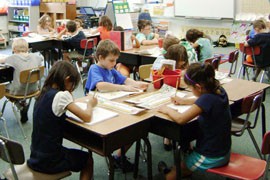Cronkite News has moved to a new home at cronkitenews.azpbs.org. Use this site to search archives from 2011 to May 2015. You can search the new site for current stories.
Arizona ranks near bottom of states on per-pupil grade-school spending
WASHINGTON – Arizona had the third-lowest per-pupil spending on public elementary schools in the country in 2010,topping only Utah and Idaho, according to a recent Census Bureau report.
Arizona schools spent an average of $7,848 per grade school student in that year, well below the national average of $10,615 per pupil, according to the Census report released in late June.
But Arizona school officials defended what they called efficient use of education dollars, noting that the state has posted some of the biggest gains on national standardized test scores despite the relatively low spending.
Since 2009, the state’s fourth-graders have posted the nation’s highest gains in the math section of the National Assessment of Educational Progress, said Molly Edwards, a spokeswoman for the Arizona Department of Education. She said Arizona schools have to determine how to deliver a quality education to students based on the funds available.
“We are always on the lookout for ways to bring in additional dollars, but we also have a responsibility not to give up just because we aren’t getting as much money as other states,” she said.
In addition to spending less per student, state funds also made up a smaller portion of total school spending in Arizona than in most other states, the report said. Nationally, state funding makes up 45 percent of school spending on average, with the rest coming from local and federal sources; in Arizona, state support makes up just 35 percent of the $8.8 billion that was spent on elementary education in 2010.
That’s just not enough, said David Garcia, a professor of education at Arizona State University.
“Education is a state responsibility, and each state, in its constitution, decides how they are going to fund education,” Garcia said.
The Arizona Constitution says the state will ensure and fund a “general and uniform” education for all students. But all that guarantees is that each school district gets the same amount of funding per pupil, Garcia said, not that students get a good education.
With 65 percent of school funding generally going to teacher salaries, schools in underfunded states can face a difficult choice between raising teacher salaries or reducing class sizes, said Mike Griffith, a finance analyst for the Education Commission of the States.
“In states that have higher funding, you often will see both smaller class sizes and higher pay,” Griffith said. “But if you walk into a class room in a lower-funded state, often you will see larger classes and lower-paid teachers – it’s an indirect correlation between spending and student achievement.”
But he cautioned that higher spending does not automatically result in schools that are getting the results they should.
“You can also find districts that don’t have as much money but have high achievement – it’s all about how they spend the money,” Griffith said.
Garcia said that the first step in solving the funding problem in Arizona is recognizing that there is a problem.
“And for anyone in education, Arizona being one of the lowest-funded states, isn’t going to be news,” he said.








